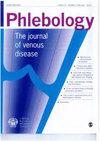盆腔充血综合征,偏头痛和扩张静脉疾病:有趣但并不奇怪。
IF 1.5
4区 医学
Q3 PERIPHERAL VASCULAR DISEASE
引用次数: 0
摘要
本文章由计算机程序翻译,如有差异,请以英文原文为准。
Pelvic congestion syndrome, migraine and dilating venous disease: Interesting but not surprising.
Dear Editor, We have recently read the exciting article published by Smith et al. with great pleasure and enthusiasm. They have admirably assessed the prevalence of coexisting symptoms and self-reported syndrome diagnoses among women with pelvic congestion syndrome (PCS). The most commonly encountered symptoms are severe fatigue (72%), dizziness (63%), irritable bowel syndrome symptoms (61%), migraines (49%), polyuria or dysuria (41%). This survey conducted by Smith et al. is an example of multi-disciplinary approach to PCS by means of self-reported co-existing symptoms or syndromes. Notably PCS, also known as pelvic varicocele, comprises the pathologic dilatation of broad ligament, ovarian plexus veins and incompetent ovarian veins and has been also classified as a member of dilating venous diseases (DVD). It has been proposed that lower extremity peripheral varicose veins, varicocele, hemorrhoids and PCS per se are not only the localized disease of related venous vascular territory but also a localized manifestation of systemic venous or vascular wall abnormality. We would like to pay particular attention on the relatively high prevalence of migraine. Given the fact that pelvic congestion syndrome or pelvic varicosities is a member and localized manifestation of DVDs, it is interesting but not surprising to see high prevalence of migraine in patients with PCS. Indeed, it has recently been documented that migraineours have a higher degree of venous leg complaints and discomfort assessed by the VEINES-Sym questionnaire compared to non-migraineours. Abnormal venous wall structure, decreased venous elasticity, increased venous pressure and eventual venous congestion of brain have also been involved in the pathogenesis of migraine. Therefore, venous circulation abnormality is likely to be a contributing factor on the pathophysiology of migraines. In this regard, coincidental high prevalence of migraine in patients with PCS deserves to be investigated to elucidate the pathophysiological association between the PCS and migraine in terms of cerebral venous vascular pathology and DVD.
求助全文
通过发布文献求助,成功后即可免费获取论文全文。
去求助
来源期刊

Phlebology
医学-外周血管病
CiteScore
3.30
自引率
11.80%
发文量
84
审稿时长
6-12 weeks
期刊介绍:
The leading scientific journal devoted entirely to venous disease, Phlebology is the official journal of several international societies devoted to the subject. It publishes the results of high quality studies and reviews on any factor that may influence the outcome of patients with venous disease. This journal provides authoritative information about all aspects of diseases of the veins including up to the minute reviews, original articles, and short reports on the latest treatment procedures and patient outcomes to help medical practitioners, allied health professionals and scientists stay up-to-date on developments.
Print ISSN: 0268-3555
 求助内容:
求助内容: 应助结果提醒方式:
应助结果提醒方式:


